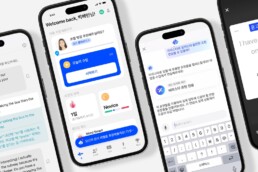Written by Dr. Peter Wonsok Yun and Don Southerton
South Korea’s Economic Rise
South Korea’s economic rise has been impressive. They have gone from one of the poorest countries in the world to one of the richest in just 50 years. This economic rise after the harsh Japanese colonial rule and the devastation of the Korean War is often referred to as the “Miracle on the Han”. This is because South Korea had no industrial facilities and was void of capital and natural resources. So what was the driving force behind this meteoric rise during the 70s? Before speaking about the digitization of Hangul, we first need to talk about Korea’s adoption of the market economy system. This system respected individuals and businesses in Korea to conduct economic activities freely.
South Korea had to rely on determination and its people as resources. One thing that South Korea did not lack was manpower. Therefore, South Korea became one of the world’s top industrial, export-driven economies. Soon South Korean conglomerates like Samsung came to dominate the industry and by 2001, South Korea’s GDP stood at $500 billion. Soon South Korea was one of the world’s top leaders in exports with over $1 trillion in total export volume. Now, South Korea has a GDP of over $1.6 trillion.
One of the most underrated aspects of South Korea’s recovery after the Korean War is Korea’s emphasis on higher education. South Korea has always valued studying and developing one itself to bring honor to the family. Therefore the country has guaranteed high-quality free education for all its citizens. They also focused on offering Koreans the highest level of education through Universities. In addition, the South Korean government has invested heavily in innovation, technology, and R&D.
Digitization of Hangul
 The digitization of Hangul (the Korean written language) has also played a major role in South Korea’s success. Hangul was created in the mid-15th century during the reign of King Sejeong in order to make Korean information independent. Hangul is linguistically a very logical and structured written language script. It is considered one of the best writing systems in the world and a great source of pride for Koreans. It even has its own holiday (October 9th Hangul Day). Then in the early 1990s, a local Korean company, today’s Hancom Group, successfully developed a native word processing program for Hangul.
The digitization of Hangul (the Korean written language) has also played a major role in South Korea’s success. Hangul was created in the mid-15th century during the reign of King Sejeong in order to make Korean information independent. Hangul is linguistically a very logical and structured written language script. It is considered one of the best writing systems in the world and a great source of pride for Koreans. It even has its own holiday (October 9th Hangul Day). Then in the early 1990s, a local Korean company, today’s Hancom Group, successfully developed a native word processing program for Hangul.
As Hangul was created in a way that common people could accurately and easily read and write the Korean language, so too, the word processing software created by Hancom allowed Koreans to communicate digitally. Soon it became the standard for Korean documents. However, due to piracy and the Asian Financial Crisis, by 1998, the company nearly went bankrupt even though it was very popular amongst Koreans and considered a national treasure.
Microsoft vs Hancom
Microsoft had a 15% market penetration in office software in Korea at the time. Therefore they were very interested in Hancom and wanted to buy them out. They offered $20 million to Hancom to stop producing its software and instead resell Microsoft’s localized Word program. This would have taken out their main competitor in Korea, one of the few countries in the world that had still resisted the wide adoption of Microsoft’s Office suite.
 Once word got out to the Korean public that Hancom was in trouble, Koreans united in a national fervor and raised over $10 million through a campaign to save the company. This goes to show just how strong nationalism was in Korea at the time. Because of this national campaign, Hancom was able to recover and is still alive today. Koreans began to pay for their software and more began to adopt and use the Hangul software in Korea. The Korean government still uses Hancom’s software. Therefore many Hangul documents can’t be converted into Microsoft Word because the two have very different conventions about layout.
Once word got out to the Korean public that Hancom was in trouble, Koreans united in a national fervor and raised over $10 million through a campaign to save the company. This goes to show just how strong nationalism was in Korea at the time. Because of this national campaign, Hancom was able to recover and is still alive today. Koreans began to pay for their software and more began to adopt and use the Hangul software in Korea. The Korean government still uses Hancom’s software. Therefore many Hangul documents can’t be converted into Microsoft Word because the two have very different conventions about layout.
Digitization of Hangul as an Economic Driver
With the rise of globalization and Korea as a nation leapfrogging economically, experts attribute much of the growth to the streamlining of both government policy and regulations. This was possible with a universally accepted digitized Hangul which was well suited to the E-Government transfer of information. E-Government refers to a government that uses technology communications devices. These include computers and the Internet, to provide public services in a country or region. Today, Korea ranks at the top of the E-Government Development Index (EGDI) of the United Nations E-Government Survey. Moon Jae-in’s two public participation policies, “Gwanghwamoon 1st Street” and “Blue House Online Petition System” allow Korean citizens to make policy proposals online. In addition, a public service portal called “Government 24″ provides tailored public services to citizens 214 hours a day.
This has also given Korea a strong competitive advantage – data management is critical in the digital age. Many of the portals created by the government contain information to provide citizens with public services. In the end, E-Government policies have enhanced the efficiency and transparency of public administration. Furthermore, it has improved services for Korean citizens.
Related Posts
Innovative Health and Wellness Startups in Korea on the Rise
November 17, 2022
Fitness Startups in Korea on the Rise
March 15, 2024





